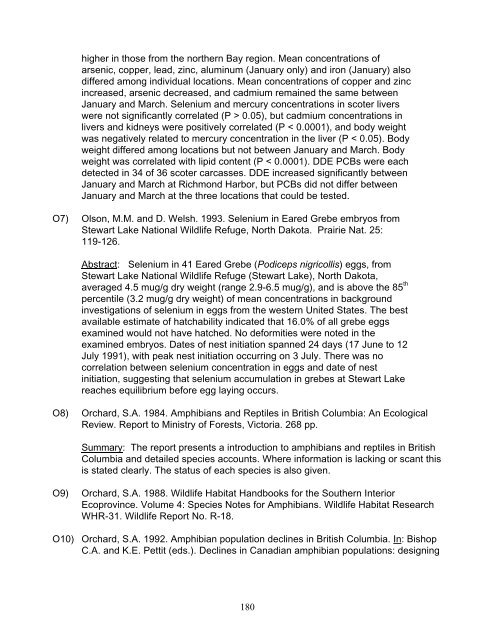Assessment of Potential Indicator Species for Monitoring ...
Assessment of Potential Indicator Species for Monitoring ...
Assessment of Potential Indicator Species for Monitoring ...
Create successful ePaper yourself
Turn your PDF publications into a flip-book with our unique Google optimized e-Paper software.
higher in those from the northern Bay region. Mean concentrations <strong>of</strong><br />
arsenic, copper, lead, zinc, aluminum (January only) and iron (January) also<br />
differed among individual locations. Mean concentrations <strong>of</strong> copper and zinc<br />
increased, arsenic decreased, and cadmium remained the same between<br />
January and March. Selenium and mercury concentrations in scoter livers<br />
were not significantly correlated (P > 0.05), but cadmium concentrations in<br />
livers and kidneys were positively correlated (P < 0.0001), and body weight<br />
was negatively related to mercury concentration in the liver (P < 0.05). Body<br />
weight differed among locations but not between January and March. Body<br />
weight was correlated with lipid content (P < 0.0001). DDE PCBs were each<br />
detected in 34 <strong>of</strong> 36 scoter carcasses. DDE increased significantly between<br />
January and March at Richmond Harbor, but PCBs did not differ between<br />
January and March at the three locations that could be tested.<br />
O7) Olson, M.M. and D. Welsh. 1993. Selenium in Eared Grebe embryos from<br />
Stewart Lake National Wildlife Refuge, North Dakota. Prairie Nat. 25:<br />
119-126.<br />
Abstract: Selenium in 41 Eared Grebe (Podiceps nigricollis) eggs, from<br />
Stewart Lake National Wildlife Refuge (Stewart Lake), North Dakota,<br />
averaged 4.5 mug/g dry weight (range 2.9-6.5 mug/g), and is above the 85 th<br />
percentile (3.2 mug/g dry weight) <strong>of</strong> mean concentrations in background<br />
investigations <strong>of</strong> selenium in eggs from the western United States. The best<br />
available estimate <strong>of</strong> hatchability indicated that 16.0% <strong>of</strong> all grebe eggs<br />
examined would not have hatched. No de<strong>for</strong>mities were noted in the<br />
examined embryos. Dates <strong>of</strong> nest initiation spanned 24 days (17 June to 12<br />
July 1991), with peak nest initiation occurring on 3 July. There was no<br />
correlation between selenium concentration in eggs and date <strong>of</strong> nest<br />
initiation, suggesting that selenium accumulation in grebes at Stewart Lake<br />
reaches equilibrium be<strong>for</strong>e egg laying occurs.<br />
O8) Orchard, S.A. 1984. Amphibians and Reptiles in British Columbia: An Ecological<br />
Review. Report to Ministry <strong>of</strong> Forests, Victoria. 268 pp.<br />
Summary: The report presents a introduction to amphibians and reptiles in British<br />
Columbia and detailed species accounts. Where in<strong>for</strong>mation is lacking or scant this<br />
is stated clearly. The status <strong>of</strong> each species is also given.<br />
O9) Orchard, S.A. 1988. Wildlife Habitat Handbooks <strong>for</strong> the Southern Interior<br />
Ecoprovince. Volume 4: <strong>Species</strong> Notes <strong>for</strong> Amphibians. Wildlife Habitat Research<br />
WHR-31. Wildlife Report No. R-18.<br />
O10) Orchard, S.A. 1992. Amphibian population declines in British Columbia. In: Bishop<br />
C.A. and K.E. Pettit (eds.). Declines in Canadian amphibian populations: designing<br />
180














